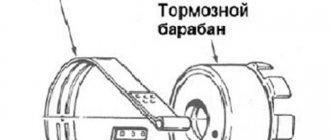Adjusting the automatic transmission cable: subtleties and nuances
As a rule, during the operation of a car with an automatic transmission, various failures and malfunctions may occur. In this case, most often the driver may notice the appearance of jerks and jolts when changing gears, a car with an automatic transmission begins to consume more fuel, etc.
In this case, there may be many reasons, but among them the automatic transmission cable should be singled out. In this article we will talk about when and why the so-called automatic transmission tuning is needed, as well as how to check and adjust the automatic transmission cable.
Shocks due to cold
The first common reason that can cause shocks when switching automatic transmissions is low temperature.
If the transmission fluid is not warmed up enough (at sub-zero temperatures), almost any automatic transmission may “kick” for some time after starting to move. However, as the box warms up, all shocks during switching should disappear (if they remain, it is better not to delay a trip to the service center for diagnostics).
Driving on unheated oil in an automatic transmission is actually quite harmful for the gearbox, since any automatic transmission is designed to operate on oil that has certain physical properties. Low temperatures change the properties of the oil, which is why some automatic transmission elements begin to experience overload.
You should not abuse the quick start of movement immediately after starting the engine in winter in a car with an automatic transmission - it is advisable to warm up the car for at least some time. Regular trips with unheated automatic transmission oil can lead to serious damage to the gearbox.
Automatic transmission cable: how to adjust and check
First of all, during operation the automatic transmission cable stretches. Also, on different cars, tuning is performed taking into account a number of features.
Some other car enthusiasts adjust the cable to their own individual needs, making adjustments experimentally.
So, for those who like to drive aggressively, the automatic transmission cable needs to be tightened. For a smooth and measured ride, loosening it slightly is more suitable. One way or another, the main thing is to find the optimal balance. If the settings are made correctly, the result will be smoother gear shifts and the automatic transmission operates more smoothly.
It is not difficult to guess that the “golden mean” is determined not only by tensioning and loosening the cable. At the same time, do not forget that in addition to the automatic transmission cable, you also have to adjust the throttle cable, throttle valve, etc. Often the adjustment process also concerns the idle air valve.
To check the operation of the automatic transmission after adjustment, you need to pay attention to how gears are switched from low to high and vice versa, and in different modes. If you lightly press the gas pedal and shifts occur with jerks, this means that the automatic transmission cable is too tight. If slipping or jerking in pairs is noticeable, this indicates a strong weakening of the cable.
Also, the operation of the box should be checked separately in kick-down mode. First, you need to accelerate the car to 50-60 km/h, then release the gas pedal and press it all the way again. If, when pressed, the box “thinks”, after which a smooth jerk appears during kick-down, this indicates that the cable is loose. A sharp jerk without a pause indicates that the cable is overtightened.
Adjusting the throttle valve control cable
There is a procedure for adjusting the cable on the transmission of Toyota and other cars, which is often carried out by experienced mechanics when the car owner complains of kicks and jerks while accelerating:
- automatic transmission adjustment using a throttle valve.
But before you adjust the automatic transmission cable, you need to make sure the following correct parameters. If any of the following signs of proper operation of the machine are not met, then you should not proceed with adjusting the cable.
- the oil level must correspond to the values specified in the machine’s operating manual;
- proper operation of the power unit, integrity of the cable connections and related units;
- the pressure in the car box must correspond to that specified in the operating book;
- checking the vehicle while moving and braking.
Now let's talk about how to adjust the cable.
- Apply lubricant to it.
- Check that the cable moves smoothly.
- Unscrew the nuts.
- Press down the gas pedal.
- Start adjusting the automatic transmission cable. Try to do this halfway down or up the key stroke, so as not to overtighten or loosen.
- Stop when the stop comes out one and a half millimeters from the rubber shell, if it was not visible at all. If the automatic transmission cable sticks out strongly, you need to tighten it back.
- Fix this stop at a position between 0.9 mm and 1.4 mm from the shell.
- Release the pedal.
Attention! It is better to do this procedure with a partner. One person must be behind the wheel and press the gas pedal at the command of the person who regulates the tension of the cable under the hood of the car.
Rigidity is adjusted by decreasing the length of the cable, while loosening, on the contrary, increases it. In addition, the car owner must remember that all settings and adjustments of the cable are carried out only in a long area that is free from vehicles and people.
Read
Diagram, repair of automatic transmission 4F27E and valve body with your own hands
When setting up the device on an automatic transmission, you must carefully read the instructions for setting up the automatic transmission. Because usually everything is spelled out in detail.
If an experienced mechanic performs the procedure at a service station, then you need to be present during the setup. While one car owner presses the gas pedal lightly, another does it with force. That’s why it’s so important to customize the machine to your liking to make driving a car comfortable and convenient.
Tips and tricks
Before starting any adjustments, you need to clearly understand what result needs to be achieved as a result of the automatic transmission settings. If you need smooth shifting, the cable needs to be loosened (the cable is lengthened when one adjusting nut is unscrewed and the other is tightened).
Also, we should not forget that the throttle cable and its adjustment also help influence the operation of the automatic transmission. The main thing is to perform each operation correctly, clearly understanding what result this or that action will lead to. If everything is done correctly, the result will be a carefully tuned automatic transmission, and for a specific driver.
Why the automatic transmission kicks, the automatic transmission jerks when changing gears, jerks, jerks and impacts occur in the automatic transmission: the main reasons.
Automatic transmission slipping when changing gears: the main reasons why an automatic transmission slips. Box diagnostics, troubleshooting.
The automatic transmission does not change gears: the car does not move forward or backward, the automatic transmission does not switch to individual gears, reasons.
How to check the operation of the box
In the following procedure, it is important to prevent the power unit from overheating. Otherwise, you may lose your automatic transmission. Checking the operation of the automatic transmission is as follows:
- Start the engine. Warm up the automatic transmission to 70 degrees. This is the operating temperature of the machine.
- Drive onto a level area and immobilize the vehicle, preventing it from moving backwards or forwards. Preferably using a handbrake and wheel chocks or stones if there are no chocks available.
- Move the selector lever to the “Forward” position.
- Press the gas pedal all the way down.
- Allow the engine to gain maximum speed, then move the selector lever to the “Neutral” gear shift position.
- Move the rocker selector to the “Reverse” position. Repeat all the steps as in the “Drive” position.
- Experts recommend spending no more than 5 seconds at each stage of the check so as not to overheat the machine.
- If there are sharp sounds or noise, the procedure must be stopped.
Read
Automatic transmission resets and does not shift gears: causes and diagnostics
Now what you should pay attention to when checking:
- the number of revolutions must correspond to the norm specified in the operating instructions. If higher, then there are problems with pressure, or the splines on the input shaft are cut. If it is lower, then this means the problems are in the freewheel;
- if normal, then the automatic transmission performs the tasks assigned to it - efficiently.
When checking an automatic transmission with an adjusted cable, you need to drive the vehicle for about twenty minutes. Pay attention to the following parameters:
- shifting gears with slight jolts - the cable is tightly pulled. Let loose;
- when slipping, the driver feels double jerks, then, on the contrary, it is necessary to tighten it more tightly;
- The transition to kick-down at a speed of 70 kilometers per hour is accompanied by a slight hitch and a subsequent smooth jerk - a slight tension. If during kickdown you feel a sharp jerk forward, then the cable will be tightened.
Guided by the above instructions, the car owner will be able to independently tighten the device without resorting to the services of service center mechanics.
Setting up and adjusting the automatic transmission cable
During the operation of the gearbox, it needs adjustments: adjusting the torsion of the automatic transmission, changing a group or one solenoid in the valve body, as well as adapting the automatic transmission after assembling the vehicle’s gearbox.
Then the car owner will be able to drive the car comfortably. He will not be disturbed by pushes and kicks if he changes the oil on time and does not starve the machine from lack of lubricating fluid.
Checking the solenoid block
Automatic transmission tuning includes checking the solenoid unit. Due to incorrect operation of the electric valves on the control plate, the machine can not only be pushed or kicked, but also go into emergency mode.
To carry out the procedure for checking the serviceability of the electrical valves of the hydraulic plate, you must take the following steps:
- Drive onto the overpass.
- Drain the operating oil and tighten the bolts on the pan. Then remove it.
- Disconnect the filter device.
- Remove the hydraulic unit.
- Disconnect the contacts of each solenoid valve.
- Now you will need to call them.
- To determine whether the solenoid is working or not, you need to know the resistance rate. It can be found in the instruction manual. For example, for EV1 modifications at a temperature of 20 plus Celsius, the resistance is 65 Ohms.
Read
DIY Nissan Juke automatic transmission repair
And also at a service station, experienced mechanics can connect a computer and use it to check the faulty solenoid. After checking, you need to remove the faulty one and install a new one.
When checking solenoids, you must remember that they are different. Here are some types:
- by functional value: TCC and EPC. The first is responsible for blocking the fluid coupling, the second is responsible for distributing oil through the channels;
- The Shift solenoid is responsible for downshifting and upshifting;
- linear - the simplest and easiest to replace solenoid valves;
- VFS is complex to control, but simple in design, like linear ones. Its service life is noticeably limited.
The solenoid valve is replaced as follows:
- Unscrew the fastening of the faulty solenoid from the valve body removed from the automatic transmission.
- Install the correct one.
- Connect it to the connectors.
- Assemble and install the hydraulic plate into the machine.
After each assembly and disassembly of the box, experts advise adapting the box. This is done in order to set up the machine for smooth operation and unquestioning obedience to the driver.
What kind of automatic transmission cable?
The automatic transmission cable regulates gear shifts in the automatic transmission. It is because of its stretching that the car appears thoughtful when switching from third to fourth gear. Sometimes the driver, on the contrary, feels a double jerk.
The automatic transmission cable needs to be tightened once a month for those cars whose car owners love aggressive driving. And it must be replaced twice as often, since the device wears out quickly. Sometimes you have to tighten not only the automatic transmission cable, but also the throttle valve, as well as the idle air valve.
In almost all automatic transmissions of vehicles, the cable has a cover. Then there is a boss in the form of a metal thickening. The device ends with two adjusting nuts.
The automatic transmission cable is made of high-quality metal. Additionally covered with a rubber shell. Drivers may experience problems with it due to the drying out of the shell. Because of this, he is often out of place.
Attention! With the correct setting of the automatic transmission cable, the vehicle will receive smooth operation and gear shifting.
Functions of the automatic transmission cable
The automatic transmission cable performs the main task:
combining the damper of the power unit and the control mechanism of the machine.
He is responsible for timely gear changes. If this element malfunctions, the machine cannot correctly change gears on the vehicle.
If the automatic transmission cable is in the wrong position, it increases the vehicle's gluttony. The automatic transmission is also subject to heavy wear.
In addition, the friction discs and the entire planetary gear suffer. Hesitation when changing gears or a sharp jerk leads to overheating and wear of the teeth of steel discs, and incorrect operation of the torque converter.
Where is the cable located?
The automatic transmission cable is located under the hood of the vehicle on the transfer case housing. It is attached at three points:
The automatic transmission cable should not be stretched or tightly taut. And also each of the fasteners to which it is attached must not be cracked or broken. In this case, you need to contact a service center to replace the vehicle cable holder elements.
Symptoms when adjustment is necessary
Adjusting the automatic transmission cable will be necessary in the following cases:
Adjustment is necessary if, while eliminating problems with relaxation of the device, on the contrary, symptoms of a tightened cable arise. This is also harmful to the vehicle's automatic transmission.
Attention! For those who like driving with sudden starts, a tight cable tension is allowed. The main thing here is not to overdo it.
And the symptoms themselves can appear, for example, only when changing gears. Therefore, the car owner can ignore the shocks and jerks for a long time. This happens to those who have cars with a French-made Al4 gearbox. Or in Russia this device is called DP0.
Initially, the manufacturer tells car owners that the first generation has an untreated childhood illness in the form of rarely appearing kicks or hesitation when switching. The driver does not pay attention to these symptoms, the cause of which gradually leads to automatic transmission failure.
Other boxes are more advanced and do not have such serious features.











